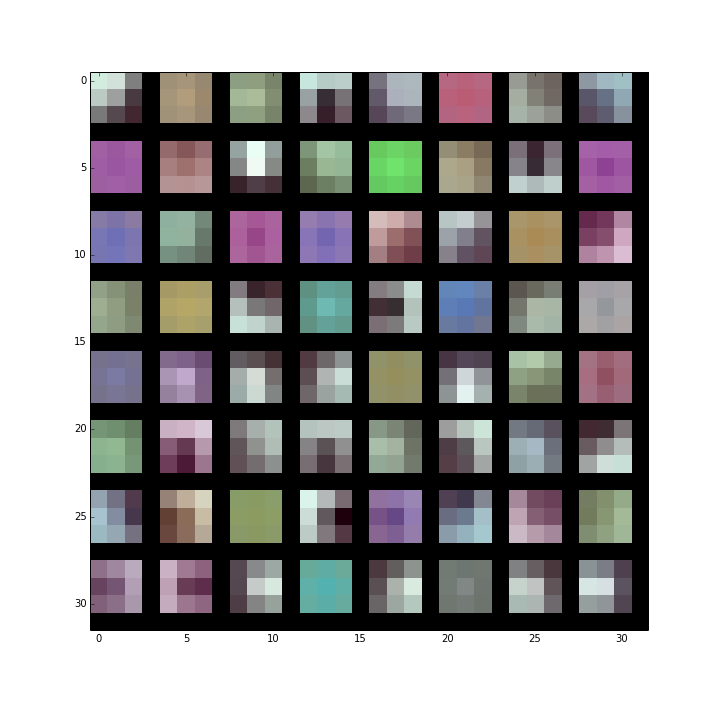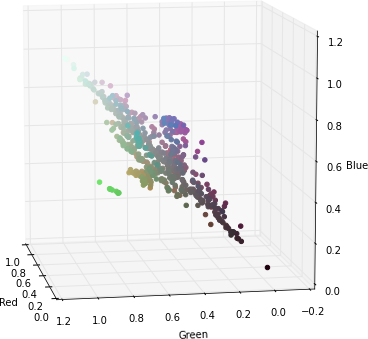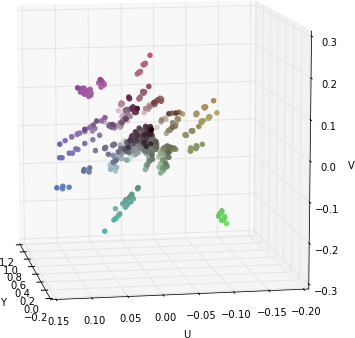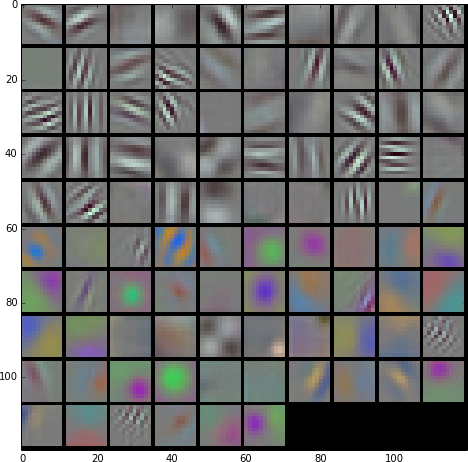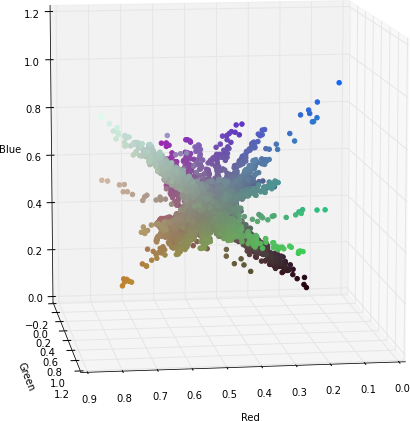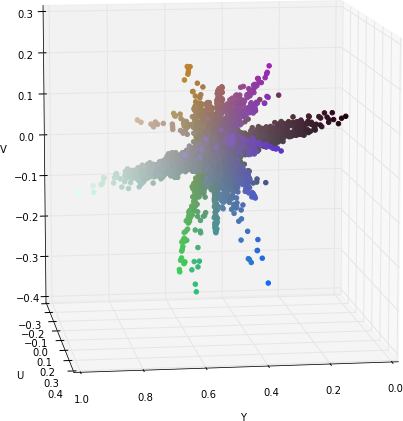Visualization of Alexnet using Graphviz. The example is a PNG as Blogger does not accept vectorial images like SVG or PDF. However, with the code below it is possible to generate a PDF calling the program "dot" with the next command:
// ================================================= //
// Author: Miquel Perello Nieto //
// Web: www.perellonieto.com //
// Email: miquel.perellonieto at aalto dot fi //
// ================================================= //
//
// This is an example to create Alexnet Convolutional Neural Network
// using the opensource tool Graphviz.
//
// Tested with version:
//
// 2.36.0 (20140111.2315)
//
// To generate the graph as a PDF just run:
//
// dot -Tpdf alexnet.gv -o alexnet.pdf
//
// One think to have in mind is that the order of the nodes definition modifies
// nodes position.
digraph Alexnet {
// ================================== //
// GRAPH OPTIONS //
// ================================== //
// From Top to Bottom
rankdir=TB;
// Tittle possition: top
labelloc="t";
// Tittle
label="Alexnet";
// ================================== //
// NODE SHAPES //
// ================================== //
//
// There is a shape and color description for each node
// of the graph.
//
// It can be specified individually per node:
// first_node [shape=circle, color=blue];
//
// Or for a group of nodes if specified previously:
// node [shape=circle, color=blue];
// first_node;
// second_node;
//
// Data node
// =========
data [shape=box3d, color=black];
// Label node
// =========
label [shape=tab, color=black];
// Loss function node
// ==================
loss [shape=component, color=black];
// Convolution nodes
// =================
//
// All convolutions are a blue inverted trapezoid
//
node [shape=invtrapezium, fillcolor=lightblue, style=filled];
conv1;
conv3;
// Splitted layer 2
// ================
//
// Layers with separated convolutions need to be in subgraphs
// This is because we want arrows from individual nodes but
// we want to consider all of them as a unique layer.
//
subgraph layer2 {
// Convolution nodes
//
node [shape=invtrapezium, fillcolor=lightblue, style=filled];
conv2_1;
conv2_2;
node [shape=Msquare, fillcolor=darkolivegreen2, style=filled];
relu2_1;
relu2_2;
}
// Splitted layer 4
// ================
//
subgraph layer4 {
// Convolution nodes
//
node [shape=invtrapezium, fillcolor=lightblue, style=filled];
conv4_1;
conv4_2;
node [shape=Msquare, fillcolor=darkolivegreen2, style=filled];
relu4_1;
relu4_2;
}
// Splitted layer 5
// ================
//
subgraph layer5 {
// Convolution nodes
//
node [shape=invtrapezium, fillcolor=lightblue, style=filled];
conv5_1;
conv5_2;
// Rectified Linear Unit nodes
//
node [shape=Msquare, fillcolor=darkolivegreen2, style=filled];
relu5_1;
relu5_2;
}
// Rectified Linear Unit nodes
// ============================
//
// RELU nodes are green squares
//
node [shape=Msquare, fillcolor=darkolivegreen2, style=filled];
relu1;
relu3;
relu6;
relu7;
// Pooling nodes
// =============
//
// All pooling nodes are orange inverted triangles
//
node [shape=invtriangle, fillcolor=orange, style=filled];
pool1;
pool2;
pool5;
// Normalization nodes
// ===================
//
// All normalization nodes are gray circles inside a bigger circle
// (it reminds me a 3 dimmensional Gaussian looked from top)
//
node [shape=doublecircle, fillcolor=grey, style=filled];
norm1;
norm2;
// Fully connected layers
// ======================
//
// All fully connected layers are salmon circles
//
node [shape=circle, fillcolor=salmon, style=filled];
fc6;
fc7;
fc8;
// Drop Out nodes
// ==============
//
// All DropOut nodes are purple octagons
//
node [shape=tripleoctagon, fillcolor=plum2, style=filled];
drop6;
drop7;
// ================================== //
// ARROWS //
// ================================== //
//
// There is a color and possible a label for each
// arrow in the graph.
// Also, some nodes has connections going in and
// going out.
//
// The color can be specified individually per arrow:
// first_node -> second_node [color=blue, style=bold,label="one to two"];
//
// Or for a group of nodes if specified previously:
// edge [color=blue];
// first_node -> second_node;
// second_node -> first_node;
// second_node -> third_node;
//
//
// LAYER 1
//
data -> conv1 [color=lightblue, style=bold,label="out = 96, kernel = 11, stride = 4"];
edge [color=darkolivegreen2];
conv1 -> relu1;
relu1 -> conv1;
conv1 -> norm1 [color=grey, style=bold,label="local_size = 5, alpha = 0.0001, beta = 0.75"];
norm1 -> pool1 [color=orange, style=bold,label="pool = MAX, kernel = 3, stride = 2"];
pool1 -> conv2_1 [color=lightblue, style=bold,label="out = 256, kernel = 5, pad = 2"];
pool1 -> conv2_2 [color=lightblue, style=bold];
//
// LAYER 2
//
edge [color=darkolivegreen2];
conv2_1 -> relu2_1;
conv2_2 -> relu2_2;
relu2_1 -> conv2_1;
relu2_2 -> conv2_2;
conv2_1 -> norm2 [color=grey, style=bold,label="local_size = 5, alpha = 0.0001, beta = 0.75"];
conv2_2 -> norm2 [color=grey, style=bold];
norm2 -> pool2 [color=orange, style=bold,label="pool = MAX, kernel = 3, stride = 2"];
pool2 -> conv3 [color=lightblue, style=bold,label="out = 384, kernel = 3, pad = 1"];
//
// LAYER 3
//
conv3 -> relu3 [color=darkolivegreen2];
relu3 -> conv3 [color=darkolivegreen2];
conv3 -> conv4_1 [color=lightblue, style=bold,label="out = 384, kernel = 3, pad = 1"];
conv3 -> conv4_2 [color=lightblue, style=bold];
//
// LAYER 4
//
edge [color=darkolivegreen2];
conv4_1 -> relu4_1;
relu4_1 -> conv4_1;
conv4_2 -> relu4_2;
relu4_2 -> conv4_2;
conv4_1 -> conv5_1 [color=lightblue, style=bold, label="out = 256, kernel = 3, pad = 1"];
conv4_2 -> conv5_2 [color=lightblue, style=bold];
//
// LAYER 5
//
edge [color=darkolivegreen2];
conv5_1 -> relu5_1;
relu5_1 -> conv5_1;
conv5_2 -> relu5_2;
relu5_2 -> conv5_2;
conv5_1 -> pool5 [color=orange, style=bold,label="pool = MAX, kernel = 3, stride = 2"];
conv5_2 -> pool5 [color=orange, style=bold];
pool5 -> fc6 [color=salmon, style=bold,label="out = 4096"];
fc6 -> relu6 [color=darkolivegreen2];
relu6 -> fc6 [color=darkolivegreen2];
fc6 -> drop6 [color=plum2, style=bold,label="dropout_ratio = 0.5"];
drop6 -> fc6 [color=plum2];
//
// LAYER 6
//
fc6 -> fc7 [color=salmon, style=bold,label="out = 4096"];
//
// LAYER 7
//
fc7 -> relu7 [color=darkolivegreen2];
relu7 -> fc7 [color=darkolivegreen2];
fc7 -> drop7 [color=plum2, style=bold,label="dropout_ratio = 0.5"];
drop7 -> fc7 [color=plum2];
fc7 -> fc8 [color=salmon, style=bold,label="out = 1000"];
//
// LAYER 8
//
edge [color=black]
fc8 -> loss;
label -> loss;
}
If you find these interesting you can take a look at the results in my Master Thesis:
and do not hesitate to ask me any question.
